Effects of helium massive gas injection level on disruption mitigation on EAST
2021-07-07AbdullahZAFARPingZHU朱平AhmadALIShiyongZENG曾市勇andHaolongLI李浩龙
Abdullah ZAFAR,Ping ZHU(朱平),Ahmad ALI,Shiyong ZENG(曾市勇) and Haolong LI(李浩龙)
1 CAS Key Laboratory of Geospace Environment and Department of Engineering and Applied Physics,University of Science and Technology of China,Hefei 230026,People's Republic of China
2 International Joint Research Laboratory of Magnetic Confinement Fusion and Plasma Physics,State Key Laboratory of Advanced Electromagnetic Engineering and Technology,School of Electrical and Electronic Engineering,Huazhong University of Science and Technology,Wuhan 430074,People's Republic of China
3 Department of Engineering Physics,University of Wisconsin-Madison,Madison,WI 53706,United States of America
4 Pakistan Tokamak Plasma Research Institute,Islamabad 3329,Pakistan
5 Department of Plasma Physics and Fusion Engineering,University of Science and Technology of China,Hefei 230026,People’s Republic of China
Abstract In this study,NIMROD simulations are performed to investigate the effects of massive helium gas injection level on the induced disruption on EAST tokamak.It is demonstrated in simulations that two different scenarios of plasma cooling(complete cooling and partial cooling)take place for different amounts of injected impurities.For the impurity injection above a critical level,a single MHD activity is able to induce a complete core temperature collapse.For impurity injection below the critical level,a series of multiple minor disruptions occur before the complete thermal quench.
Keywords:massive gas injection,MHD instabilities,major disruption,minor disruption
1.Introduction
The most encouraging methods of disruption mitigation include the injection of impurities into the tokamak before an anticipated disruption.An efficient disruption mitigation system can spread the radiated power uniformly over the first wall,immensely reducing the heat load to the PFCs.Preferably,the time scales of both thermal and current quench will be sufficiently fast to dissipate the plasma energy prior to the development of disruptive instabilities,but slow enough to prevent the generation of runaway electrons or substantial electromagnetic forces on the system[1,2].Several mitigation techniques such as MGI(massive gas injections)[3–8],shell-pellet injection[9,10],and SPI(shatter-pellet injection)[11,12]have been carried out on DIII-D[13],Alcator C-Mod[14],ASDEX Upgrade[15],JET[16,17],EAST[18,19],and J-TEXT[20,21]among other experiments.
To understand these experiments,various simulation schemes have been introduced for different timescales and phenomena involved in the disruption mitigation process.For example,2D transport codes e.g.TOKES[22],and TokSys[23]have been used to model the time scale of pre-TQ phase,whereas other 1.5D axisymmetric integrated modeling codes such as ASTRA[24]and DINA[25]allow the simulation of complete disruption phase in a moderate computational time span.The nonlinear 3D MHD codes such as NIMROD[26],JOREK[27–29]and M3D-C1[30]can simulate the time evolution of disruption mitigation when coupled with adequate impurity radiation and transport models.In particular,NIMROD,together with the coronal impurity dynamics model Killer Pellet RADiation(KPRAD),has been widely used for the MGI[31–33]and pellet injection[34,35]simulations.
Recently,effects of different injection levels on TQ onset and radiated energy losses have been studied in disruption mitigation experiments with high pressure low-Znoble gas injection on EAST[18,19],where the injected gas quantity primarily affects the duration of pre-TQ stage and the radiated energy loss.In this work,we perform NIMROD simulations to study the effect of impurity injection level on the MGI process based on an EAST discharge.We find that different levels of MGI trigger toroidal modes with different amplitudes and can indeed significantly modify the pre-TQ duration and radiated energy.In particular,we have identified a critical injection level which separates two distinctively different regimes for the MGI disruption mitigation processes.
This paper is organized as follows.The simulation model is described in section 2.Section 3 describes the typical MGI scenario reproduced in our simulations.Key results on the influence of injected impurity level are discussed in section 4.Finally,a brief summary of the main results is presented in section 5.
2.Simulation model
Nonlinear simulation of EAST disruption induced by the He gas injection is carried out with the extended MHD NIMROD code,which integrates radiation and atomic physics model obtained from the KPRAD code[36].This coupled model has been used to investigate rapid shutdown experiments in DIII-D[31–33].The equations for the coupled model are as follows:
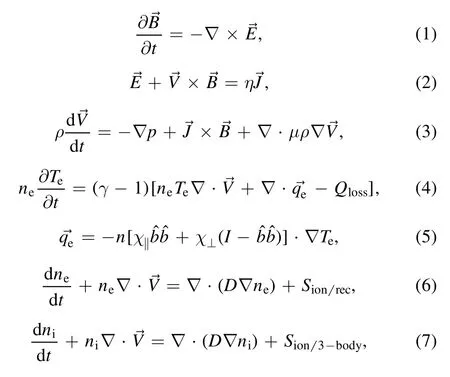

The KPRAD model is used to update the charge-state populations of impurity species at each time step and at every grid point to evaluate source terms used in NIMROD temperature and density evolution equations.The total energy loss due to impurity includes contributions from bremsstrahlung,line radiation,ionization energy,and dilution induced isobaric plasma cooling.The Ohmic heating is also present in the last term of equation(4).The deuterium is supposed to be not completely ionized,as the three-body recombination can become important at low temperatures often encountered during MGI.The source/sink term of electrons contains contributions from both ionization and recombination of the impurities.The advection and diffusion terms are computed as a part of the NIMROD time advance.
3.Typical MGI process from simulation
The equilibrium used in these simulations is constructed using the EFIT code based on the EAST discharge # 71 230 at the time of 4.8 s.The pressure(P)and safety factor(q)equilibrium profiles are depicted in figure 1.In polodial domain,we used66×66 finite elements(figure 2)with a polynomial degree of 5.The poloidal distribution of the neutral source for MEDUSA jet is shown in figure 3.Other key equilibrium parameters used in the MGI simulations are listed in table 1.A constant parallel thermal diffusivity is used in these simulations.
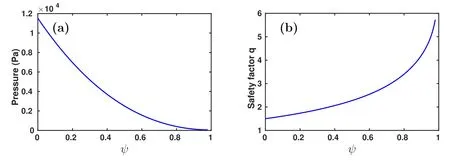
Figure 1.(a)Pressure and(b)safety factor profiles of the EAST equilibrium.
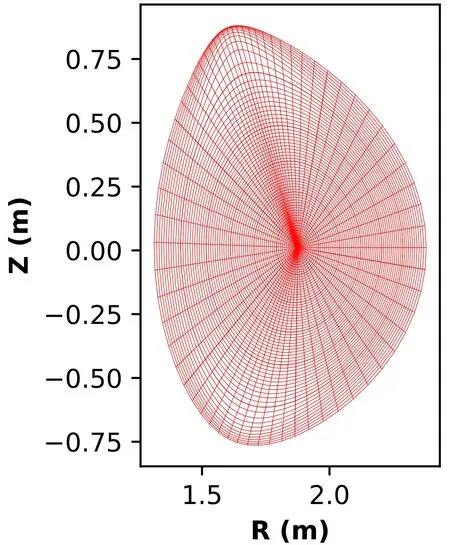
Figure 2.2D finite element mesh for the EAST configuration used in the NIMROD simulations.

Figure 3.Normalized poloidal distribution of injected neutral He for MEDUSA jet used in EAST MGI simulations.

Table 1.Main input parameters of MGI simulation.
Time evolutions of some key quantities during the MGI triggered disruption show that the pre-TQ stage lasts for 2.3 ms(i.e.fromt=0 ms tot=2.3 ms)which ends when the plasma core temperature starts to decrease(figure 4).Initially,the injected impurities are mostly distributed at the edge and then slowly diffuse towards the core.The radiated power(Prad)is therefore initially less intense due to low boundary temperature.As the cold front advances inwards and the impurities penetrates deeper,the magnitude ofPradincreases significantly.A conspicuous peak inPradis initially observed at 0.6 ms(figure 4(d)),followed by the first MHD activity(figure 4(a)),which saturates around 0.85 ms and coincides with the decrease of plasma temperature outside ofq=2 surface(i.e.the temperature drops at the radial locations 2.2 and 2.15 m)as shown in the figure 4(c).After a small delay,another spike in the radiated power occurs(t~0.95 ms),presumably due to the cold front penetration within theq=2 surface.As soon as the first MHD burst(with dominantn=1 mode)tends to decrease,the temperature collapse atq=2 and outside is initiated.
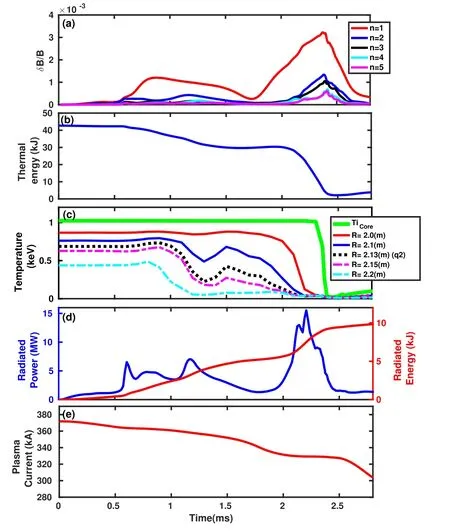
Figure 4.Time evolution of major parameters in an MGI simulation.(a)Magnetic amplitudes of n=1–5 modes(calculated as (b)thermal energy,(c)temperature at different radial locations,(d)radiation power(left)and energy(right),and(e)plasma current.
Subsequently,a second major MHD activity is triggered att~1.8 ms,where the magnetic perturbations of all modes grow substantially.Meanwhile,thePradsurges again to the maximum value of about 15 MW(figure 4(d)).The peak MHD activity and radiation power are immediately followed by the onset of TQ,when the core temperature starts to decrease at the end of pre-TQ stage(i.e.t=2.3 ms)(figure 4(c)).The magnitude of second MHD activity is significantly larger than the first one,leading to the complete collapse of core temperature(figure 4(c)).Figure 4(b)reveals that the majority of plasma thermal energy(more than 60%)is lost during the pre-TQ phase that lasts fromt=0 tot=2.3 ms due to cooling of the edge region.The radiated energy at the end of the TQ is 10 kJ(~25% of lost thermal energy)which is comparable to the EAST experimental value,which is about 25% of the total diamagnetic energy[19].The TQ phase is followed by the current quench phase(CQ),when the plasma current decays due to increased plasma resistivity,and a slight current spike at 2.5 ms is identified right prior to the start of CQ(figure 4(e)).
The time evolution of plasma profiles(impurity density,electron density,temperature,toroidal current density)and magnetic flux surfaces(Poincaré plots)during different disruption stages is illustrated in figures 5 and 6.The injected impurity enhances the electron density at the edge and cools down the plasma at the outer boundary(figures 5(b)and(c)).The plasma resistivity increases throughout the cooled-down region,leading to contraction of current profile,which triggers MHD instabilities such asm/n=3/1 and 2/1 modes(mandnare the polodial and the toroidal mode numbers respectively)(figure 6(a)).However,the 2/1 island width at this point is not prominent.As more impurity density accumulates around theq=2 surface,the current density channel shrinks insideq=2(figure 5(d))and contributes to a rapid growth of 2/1 magnetic island(figure 6(b)).By the timet=2.0 ms,the magnetic flux near theq=2 surface and its periphery outside become stochastic,whereas the magnetic surfaces inside down to the magnetic axis remain intact.At the end of the TQ,core flux surfaces are destroyed and almost the entire plasma domain becomes magnetically stochastic(figure 6(c)).The 1/1 magnetic island structure appears at the beginning of the CQ stage(figure 6(d)).The CQ phase is not elaborated further here as it is beyond the scope of this study.

Figure 6.Poincaré plots in poloidal plane at:(a)t=0.5 ms,(b)t=2.0 ms,(c)t=2.42 ms(the end of TQ),(d)t=2.5 ms(the start of CQ).

Figure 5.Time evolution of radial profiles for:(a)impurity density,(b)electron density,(c)ion temperature,and(e)toroidal current density during pre-TQ and TQ phases.
4.Influence of impurity injection level
Systematic simulations are performed for different injection levels to investigate its effect on thermal collapse.Plasma equilibrium parameters are kept same in all simulations(table 1),only the amount of injected impurities is varied.A critical injection level(4.4×1021particles)is identified,around which the TQ behavior changes distinctively.As demonstrated in figure 7(a)in the cases with injected He above the critical injection level,the electron temperature at magnetic axis drops below several tens of eV in a single step(i.e.major disruption),whereas in the case of impurity injection below the critical level,the complete drop of core temperature takes several steps after multiple fractional decrements(i.e.minor disruption).Furthermore,it is observed that the duration of pre-TQ phase is largely affected by the amount of impurity injection.By reducing the amount of injected impurities,the precursor phase stays longer,i.e.more time is required for the MHD modes to saturate and induce TQ.The lost thermal energy in each case is around 90%–95%at the end of TQ,which is significantly more than the radiated energy.In the larger injection case(NHe=4×1022particles)the radiated energy is about 10 kJ,while for the smaller injection cases(NHe=4×1021particles),it is approximately 2 kJ(figure 7(b)).This implies that a relatively small fraction of thermal energy is dissipated away through radiation due to the low-Zcharge of He gas,which may be not an efficient radiator.

Figure 7.Time evolution of:(a)core temperature drop,(b)thermal energy,and(c)radiation energy for different injection levels.
The degree of core temperature collapse is another key to distinguishing between major and minor disruptions.A disruption is triggered when the magnetic perturbation grows to sufficiently high amplitude,which is influenced by the amount of injected impurities.The magnetic perturbation level in turn affects the rate of perpendicular heat transport and the speed of drop in core temperature.To further elucidate the influence of injected impurity levels,time evolution of key plasma parameters like normalized magnetic energy,thermal energy,core temperature,radiated power and Ohmic heating power are compared side-by-side for the higher(i.e.major disruption)and the lower impurity injection(i.e.minor disruption)cases(figure 8).Significant differences in the amplitude of magnetic perturbation and radiated power are observed.Due to the stronger radiation power in the higher injection case,the TQ phase is much shorter in duration(~0.25 ms)and takes place in one single step(figure 8(I)).In contrast,in the sub-critical lower injection case,the collapse of core temperature and stored thermal energy takes much longer time(~100 ms)to complete after multiple cycles of minor collapse and recovery(figure 8(II)).In both cases,the thermal collapses correlate closely with the spikes of magnetic perturbations in both timing and magnitude,suggesting the roles of MHD activities in the effects of injection level on the TQ process.The contributions of MHD activity can be further revealed from the comparison of the mode structure in the temperature perturbation contours in the poloidal planes for the two representative injection cases(figure 9).Whereas in the higher injection level case,the MHD mode structures are radially extended between theq=2 and theq=3 surfaces,the mode structures are mostly localized around theq=2 surface in the lower injection level case.The radial locations of the modes help to confirm the consistency in their poloidal mode structures,and the radial extensions of their mode structures show correlation with the impurity injection levels.The more localized mode structure is likely a consequence from a lower MHD activity level in the case of lower impurity injection amount below the critical limit.The underlying mechanism may involve the impurity effects on both the current profile and the MHD instability itself.We plan on a more detailed study on this in future work.

Figure 8.Time evolution of(a)normalized magnetic energy,(b)thermal energy(left)and core temperature(right),(c)radiated power(left)and Ohmic heating(right),for helium injection levels above(NHe=4×1022 particles)(I)and below(NHe=4×1021 particles)(II)the critical value.
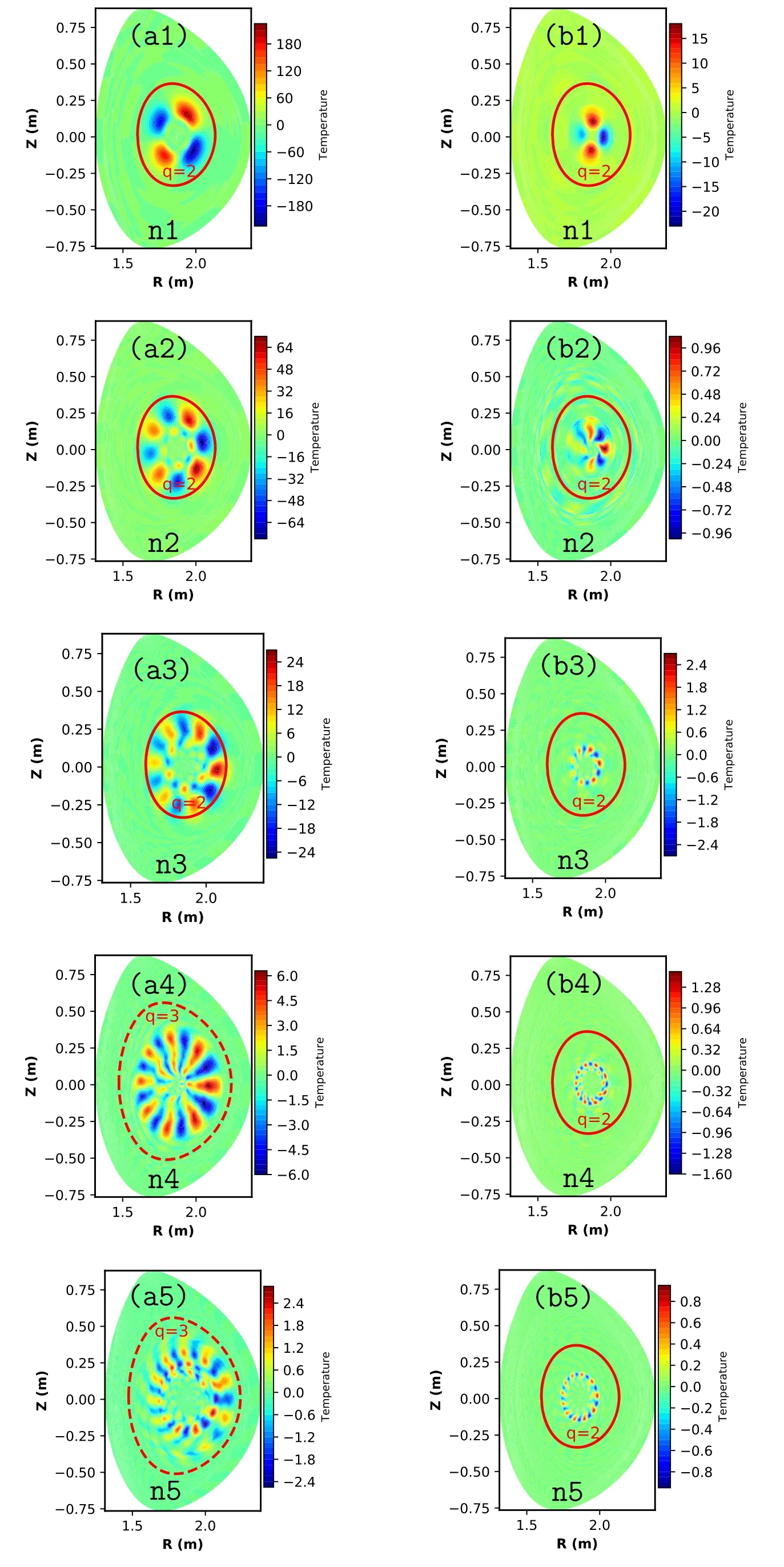
Figure 9.Temperature contours of all toroidal modes with the toroidal mode numbers n=1–5 for helium injection level above(NHe=4×1022 particles)((a1)–(a5),t=2.3 ms)and below(NHe=4×1021 particles)((b1)–(b5),t=19.5 ms)the critical value.
5.Summary
In summary,a critical injection level has been identified in the simulations of the EAST MGI process.It has been demonstrated that a strong MHD burst leads to the destruction of global confinement and achieves complete thermal collapse in a single step(major disruption)when injection level is above the critical level.However,in case of injected He gas amount below the critical level,the cooling from impurity radiation is relatively weak,resulting in smaller amplitude of MHD activity.As a result,there are several cycles of partial collapses(i.e.minor disruptions)and recoveries until the core temperature drops to a few tens of eV(i.e.complete TQ).For both high and low injection levels,the magnitude,the mode structure,and the timing of MHD activities correlate closely with those of the thermal collapse events during the MGI process.Such a correlation signifies the role of the impurity radiation induced MHD instability as the key underlying mechanism that governs the disruption mitigation physics.
Our simulations in this work are based on an EAST equilibrium that is obtained from an L-mode Ohmic discharge.For an H-mode discharge,the equilibrium profiles can be quite different,and the same level of MGI may lead to different MHD instabilities.How the current findings for an L-mode discharge may be extrapolated to H-mode remains to be explored in future studies.Whereas the existence of a critical impurity injection level that distinguishes different MGI disruption mitigation regimes is expected to persist in other devices and experiments,further simulation and experimental studies including different device and operation regimes are required in order to establish the theoretical or empirical scaling that would allow a quantitative extrapolation of the critical impurity injection amount found in this work.The development of a predicate model or scaling for the critical injection level would be helpful for the design and practice of MGI disruption mitigation scheme,which may require more quantitative understanding of the impurity injection and the induced MHD processes.We plan on looking into this direction in future studies.
Acknowledgments
This research was supported by the National Magnetic Confinement Fusion Science Program of China(No.2019YFE03050004),National Natural Science Foundation of China(Nos.11775221 and 51821005),US DOE(Nos.DEFG02-86ER53218 and DESC0018001),and the Fundamental Research Funds for the Central Universities at Huazhong University of Science and Technology(No.2019kfyXJJS193).We are grateful for the support from NIMROD team,and to Dr.Songtao Mao and Dr.Yanmin Duan of the EAST experimental group for providing the initial equilibrium data.This research used the computing resources from the Supercomputing Center of University of Science and Technology of China.The author Abdullah Zafar acknowledges the support from the Chinese Government Scholarship.
杂志排行
Plasma Science and Technology的其它文章
- Rice plant growth and yield:foliar application of plasma activated water
- Three-dimensional non-equilibrium modeling of a DC multi-cathode arc plasma torch
- Magnetic field induction and magnetic force distribution profiles in plasma focus discharge device
- Comparison of sample temperature effect on femtosecond and nanosecond laser-induced breakdown spectroscopy
- An active tunable Fano switch in a plasmafilled superlattice array
- Enhanced removal of ultrafine particles from kerosene combustion using a dielectric barrier discharge reactor packed with porous alumina balls
